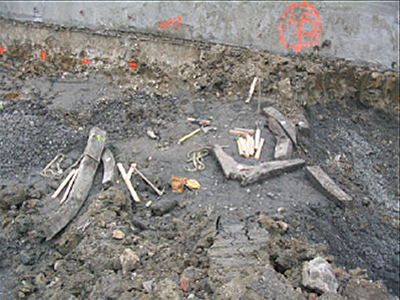
Ghastly Piles of Marine Debris

Portion of Hare’s ship breaking yard with ten ship timbers and ship breaking tools.
It was a laborious and methodical task to bring a once-working, intact vessel to a "ghastly pile of marine debris." From historical documents and photographs, maritime archaeologist Dr. James P. Delgado has reconstructed the dismantling process that Hare's ship breakers may have undertaken. In sequence, they would have:
-Removed the smaller, valuable and reusable items such as anchors, chain, blocks, tackle and other hardware.-Removed the superstructure and masts. One mast may have been left to serve as a crane to facilitate the removal of larger timbers in the hull.
-Removed the decks, along with the ceiling (inner hull planking) and outer hull planking.
-Dismantled the frames.
-Piled the timbers with valuable fastenings on shore for the secondary process of removing the fasteners. After the fasteners were removed, either through extraction or splitting the timber, the timber could be cut up further for reuse as firewood.
-Stripped off the copper sheathing from the lower hull and continued the breaking of the hull down to the keel.
-Cut up the keel into short, manageable sections for the removal of fasteners and sheathing ashore.
-Removed the last mast and break, either completely or partially, the bow or the stern (depending on which end the ship breaking had begun).
Previous Next
